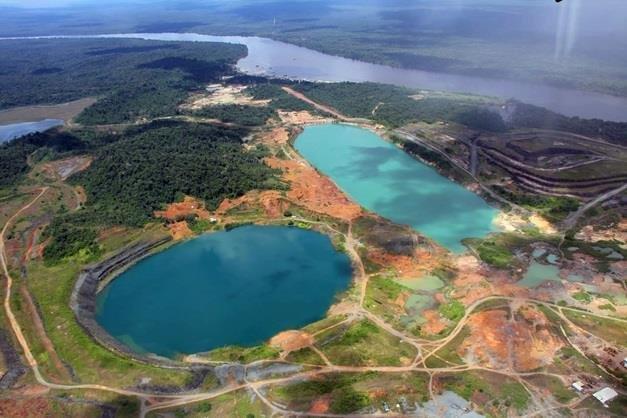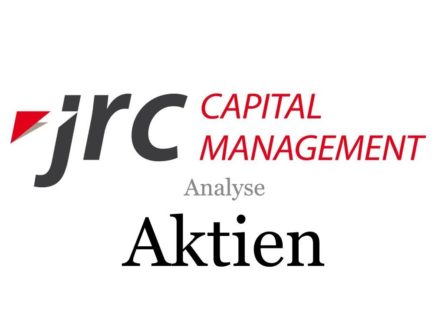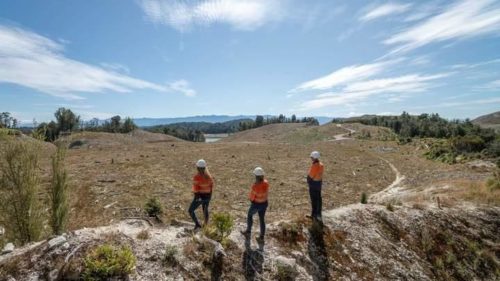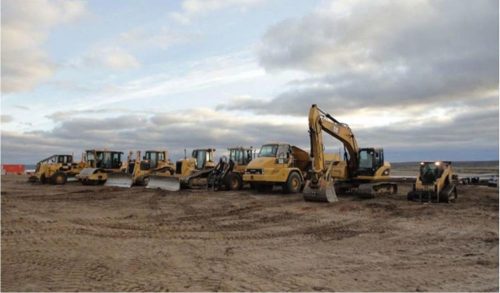
Omai Gold Mines Steps Out Successfully At Wenot Deposit
As a reminder, Omai Gold Mines already has delineated the Wenot deposit with a 2022 NI43-101 resource estimate (1.64Moz @ 1.5g/t Au, another adjacent mineralized envelope (Fennell) has a historic resource estimate of about 1.5Moz @ 1.5g/t Au. Omai is looking to bring out an updated resource for both Wenot and Fennell in October, which should definitely increase the intrinsic value of the company a great deal in my view. Their newly added director Don Dudek seems to think so too, enthusiastically joining forces in June.
All presented tables are my own material, unless stated otherwise.
All pictures are company material, unless stated otherwise.
All currencies are in US Dollars, unless stated otherwise.
Please note: the views, opinions, estimates, forecasts or predictions regarding Omai Gold Mines’ resource potential are those of the author alone and do not represent views, opinions, estimates, forecasts or predictions of Omai or Omai’s management. Omai Gold Mines has not in any way endorsed the views, opinions, estimates, forecasts or predictions provided by the author.
On July 13, 2022, Omai Gold Mines announced the second batch of results of the ongoing exploration program at their Omai gold project in Guyana. The company drilled another 14 diamond drill holes totaling 3,403m east and west of the Wenot deposit, for a total of 19 holes and 4,826m. Management is pretty busy, as it is working on 5 different targets at the moment, and on its way to revise both the Wenot and Fennell (historic) resources, consolidating them into one NI43-101 compliant resource estimate. More on this later.
About one month before this, the company announced the of Don Dudek as a new director. Dudek is a well-known name in the mining industry, and is a geologist with over 40 years of experience in various technical and corporate roles with junior to senior exploration and mining companies. He recently served as President and CEO of Savary Gold Corp., which was sold to Semafo Inc. in 2019. He has held senior technical roles for a number of mining companies including Endeavour Mining Corporation, Avion Gold Corporation and Aur Resources, and is currently Vice President Exploration for Wolfden Resources Corporation and Technical Director for Desert Gold Ventures. CEO Ellingham was very enthusiastic about Dudek, as he isn’t just very experienced, but is very enthusiastic about Omai and the potential to grow into a very significant gold deposit. He has already collaborated with her on exploration strategies.
Talking about exploration, Omai Gold Mines utilized a second drill rig a few months ago, enabling management to test multiple targets at once. The clear focus for now is on expanding the Wenot resource on trend, to the west and the east of the existing open pit, after drilling mineralization below this open pit. Expanding the Wenot resource into these un-mined areas is significant for an ultimate mine plan as these could contribute to lower-strip-ratio starter pits for the larger Wenot deposit.
Omai Gold Mines has the advantage of having a pretty good idea about more near surface mineralization at Wenot, as historic drilling tested this shallow mineralization in the saprolite layer, and the necessary data for a resource update is available. Most importantly: almost all intersected deeper zones run upwards to the shallow mineralized saprolite anyway, as visualized in a typical cross section:
Another aspect that seems to be typical for this deposit is the predictability of the width and grade of the vein structures from near surface to depth. This gives management more confidence, not only in the mineral resource estimate but also to the potential to expand the economic resources further at depth. Let’s have a look at the actual results.
Holes 22ODD-041 to 046 were reported in the latest news release, testing eastern and western extensions of Wenot, and full results can be seen here:
These results confirm that the Wenot shear-hosted gold mineralization extends to at least 900 metres west of the past-producing pit and 400 metres east of the pit, for a total strike of at least 2.7 km, which remains open along strike.
CEO Elaine Ellingham was pleased with the outcome so far: “These results indicate an exploration target with a size of at least 2.7 km long, by 450 m deep, by 200-300 m wide, with only 50% of this larger area having been drill tested, and outside of the pit area, only by wide-spaced holes or very shallow historic holes. The Wenot shear corridor is a regional structure and it is highly likely that the gold-bearing zones extend beyond the drill-tested area."
"We are sufficiently funded to advance our exploration program to the next significant milestone of expanding the gold resources on our Omai project through our drilling at Wenot and our renewed study of the Fennell historic resource. Once the current phase of Wenot drilling is complete, an updated NI 43-101 resource estimate will commence. We expect to re-start work shortly on some of the nearby exploration targets, including unexplored areas along the eastern extension of the Wenot shear corridor that continues four to five kilometres along strike, onto our adjoining Eastern Flats property.”
I found it very interesting to read about a renewed study of the Fennell resource. When discussing this with CEO Ellingham, it appeared they are planning to complete a consolidated NI43-101 compliant resource estimate containing both Wenot and Fennell. The cut-off for drill results of Wenot will be August 15, 2022, and most surprisingly, Fennell doesn’t need any new verification drilling. As far as I know, the regulators usually want companies to redrill at least 10-15% of a historic resource, but according to Ellingham, Omai still has enough of the historic drill cores with collar locations very well documented in its possession, along with original assay certificates and core photos. It appeared a company just needs at least 10% of existing cores for verification, so redrilling isn’t necessary. As long as a QP of a company validates the interpretations of such cores, the regulators rarely go against a QP according to CEO Ellingham. This is an interesting development, as a few months ago it seemed Omai had to drill 4-5 deep holes, which would be costly and timeconsuming, so it was initially postponed until Wenot expansion drilling would have been finalized. Fortunately CEO Ellingham saw a possibility to speed things up anyway, which could add lots of ounces very quickly.
When discussing resource potential for both deposits, it appeared that Wenot could contain an open pittable 1.9-2.0Moz Au, so a potential increase of 0.3-0.4Moz Au, and Fennell could be high-graded, leading to a hypothetical underground maiden resource of 700-800koz Au, at a potential average estimated grade of 3.5-4g/t. This is a pretty good development, as the current average grade of the historic Fennell resource was just 2.5g/t (for 1.4Moz Au), which wasn’t sufficient enough for incorporation into a mine plan (underground mining at current gold prices in this setting needs about 3.5-4g/t Au). The beauty of this Fennell resource is, that the highest grade parts are located closest to the surface, including the three intercepts over 1,000g/t @ 1m:
Another aspect of the current exploration program I found pretty interesting was the discovery of gold mineralization in sediments, besides the known gold within the volcanic rocks. Both 2021 and 2022 drilling has shown that the dikes and other shears also penetrated the sedimentary layers where they host similar gold mineralization. At the western extension, the mineralized zones in the sediments are even wider with similar grades. Hole 22ODD-051 was recently completed in this area and tested well into the sediments, with results pending.
As a reminder, Omai Gold Mines also drill tested west of the Fennell pit and to the southwest of the Wenot pit, in order to potentially find new deposits. Eight holes were been drilled, and assays were returned for the first 5 holes totaling 1,213m. Drilling at the Blueberry Hill target provided the following results of 3 holes.
Although hole 033 delivered a strong result, holes 034 and 035 didn’t, and this is caused by the complex geology, after high grade sampling indicated lots of potential. Hole 22ODD-036 tested a target south of the main east-west trending Wenot Shear, but returned no anomalous gold. Hole 22ODD-037 tested a geophysical target 220m south of the main Wenot Shear trend, and a few anomalous intercepts generated 6m @ 0.67g/t Au, 1m @ 0.77g/t Au and 1m @ 0.96g/t Au. Holes 22ODD-038 and 22ODD-039 tested western extensions of the Wenot gold zones, returning 8.5m @ 5g/t Au and 17.1m @ 2.32g/t Au. Holes 22ODD-040 and 22ODD-042 tested a northeast trending Snake Pond zone, resulting in 0.7m @ 2.1g/t Au in 040, leaving hole 042 with no significant intercepts.
Current exploration plans foresee a further 1200m of drilling until mid-August, and the next drill program will likely consist of 5000m and if a new raise is successful, this could commence mid-October.
In a nutshell it seems that Wenot extension drilling and the redefinition of Fennell is the fastest route towards more ounces for now, with the other targets needing more attention and drilling than was anticipated at first, because of the very strong sampling and geophysical results. I’m not too bothered by this, as Omai has lots of targets to review, the geology could be more complex and just needs more studying, and exploration of the targets outside Wenot and Fennell is still at an early stage. More important for now is the direct 2.6-2.8Moz Au potential, scheduled to be NI43-101 compliant for the second half of October of this year, and as usual I like to see where the company could fit into the context of peers and their respective valuations.
As Omai Gold Mines is a gold developer in Guyana working on a potential open pit/underground project, it is not that easy to find good peers for a peer comparison, as not too many single project junior developers are around in the region, let alone OP/UG single project juniors. For now I opted for OP/UG single project juniors in the Northern Americas, in this case exclusively Canada. What I will do in a next phase as it is a lot of work, is adding a few Latin American single project UG or OP developers, a number of Northern American single project UG or OP developers, see if I can normalize the influence of jurisdiction, and in turn see if I can interpret/extrapolate the current set of metrics provided by these Northern American single project OP/UG developers.
In general as a continuous reminder for investors, a peer comparison as a valuation method isn’t perfect as every single company has a unique set of parameters and should actually be analyzed in full and normalized as far as this is possible of course, and for example EV/oz doesn’t say much about profitability of the project yet, potential high capex, potential permitting issues, capability of management etc, but with some comments to go with such a peer comparison it provides at least an indication, which is my intention. The main intent for peer comparisons is a basic valuation tool by trying to find the most equal companies regarding quality and size of projects, jurisdictions, financial situation, backing, management, permitting, in short everything that makes every project and company so unique in this space. The better the resemblance, the more useful the company for a comparison.
I picked a number of companies with one open pit/underground flagship asset, all having at least a recent resource, all of them in the Americas, gold-focused, and as I feel Omai Gold Mines could expand their resource meaningfully in the coming years, I added a number of larger developers as well. The first table is mentioning basics like structure, enterprise value and jurisdiction:
Please note that Genesis Metals was taken over by Northern Superior not too long ago. The second table shows resource figures, and the important metric EV/oz for developers:
An interesting peer project would have been Toroparu, also located in Guyana, also an open pit/underground project and owned by Gold X Mining, a company which got acquired by GCM Mining for C$315M. This project was at PEA stage when acquired in 2021, and contained over 10Moz AuEq. This would have meant an EV/oz of about C$30/oz. Because of the low gold grade (on average 1.42g/t) and the large underground component, this deposit wasn’t economic until gold rose past $1500/oz. The current owners are busy delineating a high grade structure in the deposit, hoping to add profitability. Notwithstanding all this, there clearly is demand for Guyana deposits, and I view Wenot and Fennell as much more economic compared to Toroparu, which fetched C$30/oz nevertheless.
If Wenot could indeed go to 1.9-2.0Moz Au, and Fennell could be converted into 700-800koz Au, a combined resource could come in to the tune of 2.6-2.8Moz Au. This would result, at an EV of C$17M, in an EV/oz metric of 6.1-6.5, which is very cheap when looking at their peers. If we would use the Toroparu EV/oz figure of C$30/oz, the Omai EV would be C$78M, which is about 4.5 times higher than the current EV.
Although we are not talking about Canada as a jurisdiction here, Guyana is stable, and a very reliable working environment for those who have experience and the right networks, and Omai Gold Mines has both in spades. According to CEO Ellingham, for example permitting is expected to be much faster as Omai isn’t working anywhere near local communities, and the government is very pro mining. As its combined resources seem to be much more economic than for example the equally low priced Chevrier, which has too much low grade underground mineralization in my view, on top of a very complex geology (which Omai also doesn’t possess fortunately), it seems likely Omai might be considered undervalued when the updated resource estimate comes out in October.
The recent sell-off in most mining stocks the last few months has done a lot of damage to their charts, Omai Gold Mines not excluded, and no matter how you slice it, if we are experiencing a temporary dead cat bounce or a bottom-forming process, Omai could be very cheap at the moment.
On a closing note, the current cash position of Omai Gold Mines is C$2.0M, and the company is currently planning a financing later this year, for about C$4-5M, and are looking at possibilities of finding a strategic partner for a 9.9% interest.
Conclusion
Drilling the extensions of the Wenot deposit seems to be easy exploration for Omai Gold Mines, as almost all holes have hit mineralization so far. As Wenot geology is very predictable, the company doesn’t anticipate much trouble delineating more mineralization closer to surface, also helped by historic drilling. Besides updating the Wenot resource, Omai also hopes to include a maiden resource on Fennell in the resource estimate, which will generate a significant increase in gold ounces. This is a positive development, as more ounces means more interest by investors and suitors, as larger and economic deposits are becoming increasingly rare. Some comparing of peers points towards potential undervaluation when the resource statement will come out, and barring a black swan event, Omai Gold Mines appears to be more and more in bargain territory in my view.
I hope you will find this article interesting and useful, and will have further interest in my upcoming articles on mining. To never miss a thing, please subscribe to my free newsletter at www.criticalinvestor.eu, in order to get an email notice of my new articles soon after they are published.
Disclaimer:
The author is not a registered investment advisor, and currently has a long position in this stock. Omai Gold Mines is a sponsoring company. All facts are to be checked by the reader. For more information go to www.omaigoldmines.com and read the company’s profile and official documents on www.sedar.com, also for important risk disclosures. This article is provided for information purposes only, and is not intended to be investment advice of any kind, and all readers are encouraged to do their own due diligence, and talk to their own licensed investment advisors prior to making any investment decisions.
Swiss Resource Capital AG
Poststrasse 1
CH9100 Herisau
Telefon: +41 (71) 354-8501
Telefax: +41 (71) 560-4271
http://www.resource-capital.ch
CEO
Telefon: +41 (71) 3548501
E-Mail: js@resource-capital.ch
![]()




